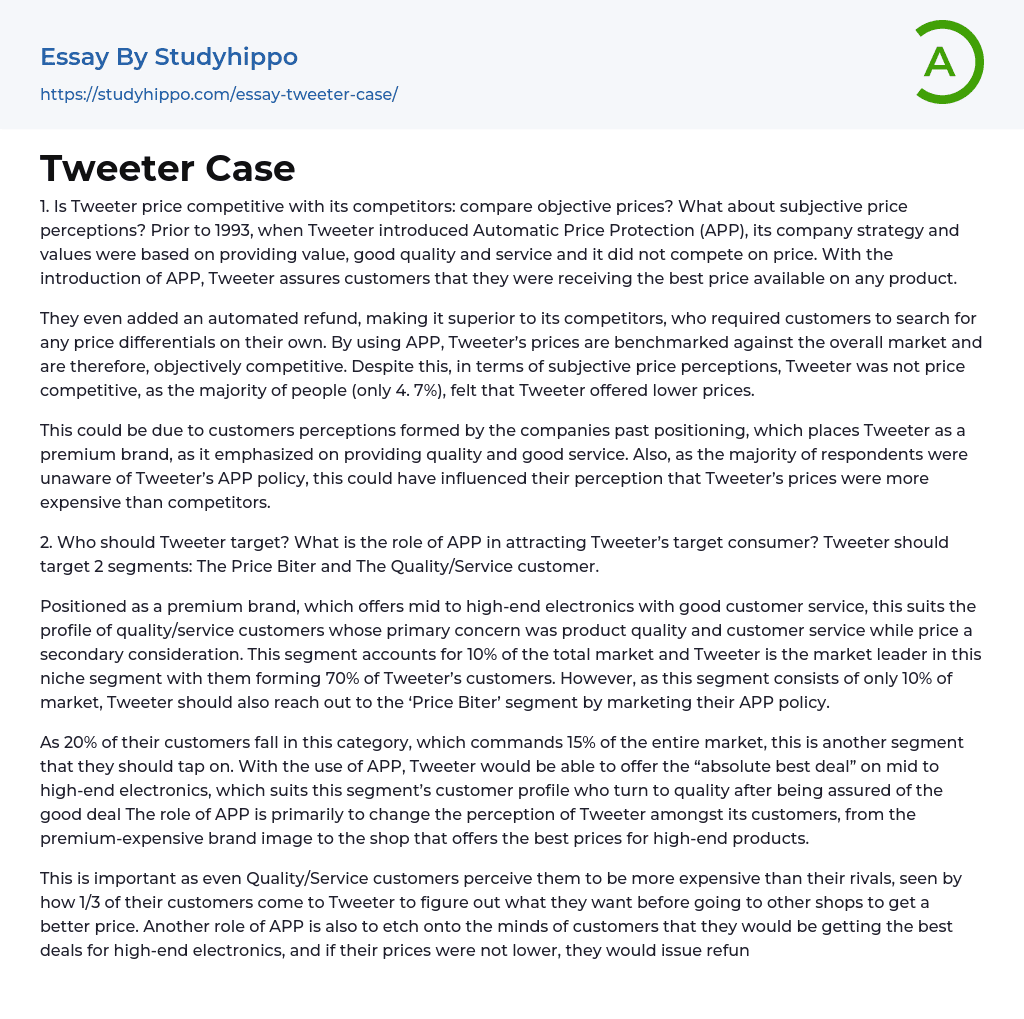1. Is Tweeter price competitive with its competitors: compare objective prices? What about subjective price perceptions? Prior to 1993, when Tweeter introduced Automatic Price Protection (APP), its company strategy and values were based on providing value, good quality and service and it did not compete on price. With the introduction of APP, Tweeter assures customers that they were receiving the best price available on any product.
They even added an automated refund, making it superior to its competitors, who required customers to search for any price differentials on their own. By using APP, Tweeter’s prices are benchmarked against the overall market and are therefore, objectively competitive. Despite this, in terms of subjective price perceptions, Tweeter was not price competitive, as the majority of people (only 4. 7%), felt that Tweeter offered lower prices.
This could be due to customers percepti
...ons formed by the companies past positioning, which places Tweeter as a premium brand, as it emphasized on providing quality and good service. Also, as the majority of respondents were unaware of Tweeter’s APP policy, this could have influenced their perception that Tweeter’s prices were more expensive than competitors.
2. Who should Tweeter target? What is the role of APP in attracting Tweeter’s target consumer? Tweeter should target 2 segments: The Price Biter and The Quality/Service customer.
Positioned as a premium brand, which offers mid to high-end electronics with good customer service, this suits the profile of quality/service customers whose primary concern was product quality and customer service while price a secondary consideration. This segment accounts for 10% of the total market and Tweeter is the market leader in this niche segment with them forming 70% of Tweeter’s customers. However
as this segment consists of only 10% of market, Tweeter should also reach out to the ‘Price Biter’ segment by marketing their APP policy.
As 20% of their customers fall in this category, which commands 15% of the entire market, this is another segment that they should tap on. With the use of APP, Tweeter would be able to offer the “absolute best deal” on mid to high-end electronics, which suits this segment’s customer profile who turn to quality after being assured of the good deal The role of APP is primarily to change the perception of Tweeter amongst its customers, from the premium-expensive brand image to the shop that offers the best prices for high-end products.
This is important as even Quality/Service customers perceive them to be more expensive than their rivals, seen by how 1/3 of their customers come to Tweeter to figure out what they want before going to other shops to get a better price. Another role of APP is also to etch onto the minds of customers that they would be getting the best deals for high-end electronics, and if their prices were not lower, they would issue refunds automatically, which makes it attractive for both customer segments. Once aware of the competitive prices offered, the “Price Biters” would turn to Tweeter due to their service and quality provided.
3. Has APP been effective? Based on the above analysis, what are the necessary factors for APP to be effective? APP has been ineffective. Despite the doubling of sales, there are no clear indication that this was brought about purely by APP or if it was due to the increase in stores. Though implemented to
differentiate itself, results shows that it has failed, only 22% of customers surveyed were aware of Tweeter’s APP policy and only 4. % of customers perceived Tweeter to offer lower prices than its competitors. For APP to be effective, Tweeter has to improve marketing efforts to highlight the automatic refund process that gives it a competitive advantage. Customers need to know that if Tweeter’s prices are not the lowest, they would be automatically refunded, a service not provided elsewhere. Tweeter also needs to educate customers in the industry on the benefits of APP as 40% of customers still do not know about it or think they are similar to its competitor’s programs.
- Chief Executive Officer essays
- Convenience Store essays
- Firm essays
- Training And Development essays
- Unilever essays
- Variable Cost essays
- Virgin Group essays
- Bargaining essays
- Entity essays
- Pest analysis essays
- Anatomy and Physiology essays
- Addiction essays
- Biodegradation essays
- Dental Care essays
- Disease essays
- Disorders essays
- Health Care essays
- Intelligence Quotient essays
- Nutrition essays
- Olfaction essays
- Public Health essays
- Women's Health essays
- World health organization essays
- Cancer essays
- Infectious Disease essays
- Lung Cancer essays
- Neurology essays
- Physical Exercise essays
- Medicine essays
- Sex essays
- Inquiry essays
- Disability essays
- Poison essays
- Action Potential essays
- Nervous System essays
- Childbirth essays
- Puberty essays
- Blood essays
- Kidney essays
- Neuron essays
- Body essays
- Glucose essays
- Sense essays
- Heart essays
- Skeleton essays
- Human Physiology essays
- Eye essays
- Immune System essays
- Muscle essays
- Skin essays




